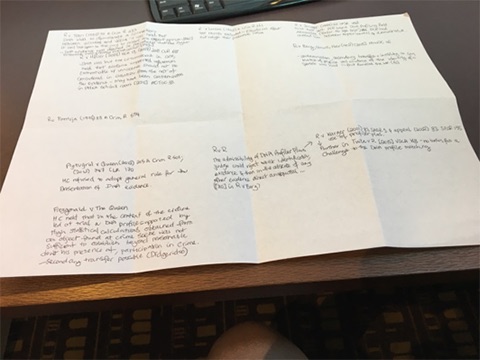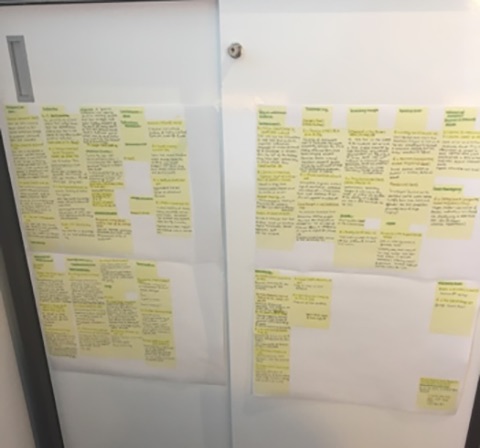
I was having difficulty in organising the case law that I wanted to talk about in my thesis so that it worked as a narrative, not as disjointed notes. I needed to find the links between cases relating to the different areas relating to DNA evidence, but where to start?
Everything seemed relevant.
Sitting down in front of my computer for another day of writing seemed overwhelming. It was hard to focus my thoughts in an organised way. I want to write, but where should I begin, what is my structure? I tried writing the cases up in a document, this quickly got out of control. Writing a long list of incoherent thoughts might seem like a way to make sense of my train of thought, but such ramblings only cause more pain at editing time.
I read Inger’s recent post on ‘Using diagrams as research aides’ and thought, why not do a map of the cases?
When I was an undergraduate law student I had used flow charts to help map different legal processes, theories, and cases. Representing things visually really helped me in my recall. It is something I suggest to students I teach, but somehow I had forgotten that this was a useful tool for me personally in processing and organising information.
So I decided to sit down with an A3 piece of paper and start to write the relevant cases down that I wanted to write about… however, I then started to change my mind about the flow of the cases and ended up with a failed, static flow chart:

I didn’t want to waste time rewriting everything and so the idea to use post-it notes came to mind. This is not a new concept, but in the haze of my final year of my PhD I don’t always think clearly.
I started filling in post-it notes and sticking them to my cupboard door (yes, staff will go past your office and think you are going a little crazy as you surround yourself with post-it notes). This helped me start to see where cases naturally grouped together well.
Once I had done about three-quarters of the cases I could see themes that I could use as a logical progression of the case law in Australia (and interesting international case law). I could also see why they are important to my thesis. It helped me to identify cases that, while not directly dealing with DNA evidence, were important steps towards a legal development. Further, it helped me identify cases that I liked but really did not work and should exclude.
I then added headings, which, if a case had an overlap with another area, but it wasn’t the main finding for that heading, I wrote the case citation on the heading. This will help me continue linking between all the sections when writing. I highlighted the headings and cases to make it stand out more. After this I stuck them to A3 paper and photocopied them. I had something that looked like this:

The best part of this process is that if I change my mind and want to include additional cases I can easily move the post-it notes and re-photocopy my flow chart.
For the time being I have put the photocopies on my cupboard door as an easy reference and continue to add additional cases. While this seems like such a basic organisational thing to do, I sometimes forget that I can use different processes to help me with my writing.
This is what I have so far:

I sat down with these A3 pieces and wrote 7,000 original words in a day! Now I feel like the hard part has been completed and the task of writing it up feels much less daunting. Most importantly, it was fun to do it this way and helped with my motivation with writing this chapter.
It also helps that I love stationary so it was fun to have a valid excuse to raid the stationary cupboard at university and use post-its and highlighters. (This is not a paid endorsement of post-it notes but I would happily receive free post-it notes or sponsorship from stationary stores!).
Author Bio:Jessica Ritchie is a PhD student at the TC Beirne School of Law at the University of Queensland.
